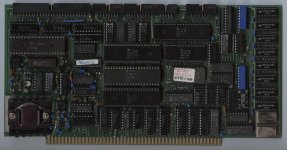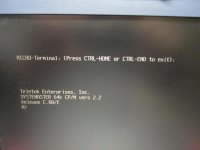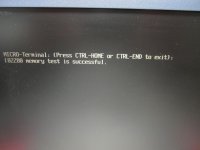BubbaShakers
Member
I recently acquired a complete system on fleabay consisting of the following:
I originally acquired this setup to get a vintage terminal and drives for my imsai, but after examining the system further (which appears to have been well kept and used at least until '80s/early '90s judging by the disk labels), I'd like to try and get the system going as configured. The terminal is definitely working as I have it hooked up through a usb serial adapter to my iMac currently. As for the system, PS voltages appear to be good, but I'm not getting very far trying to bring it up (I can't get anything from the terminal). I'd be very surprised if the drives work at this stage, so what I'd like to do is verify the systemaster itself is functioning (e.g. get into a system monitor) before worrying about the drives. It's unclear from reading the manual if this is possible, as apparently the system tries to boot from a floppy before the serial port is active.
Another issue is that it's unclear which serial port drives the terminal. I found two versions of the systemaster manual online -- one claims SIOA should be connected to the terminal, the other claims SIOB. What I have tried is the following.
Does anyone have a systemaster? Is there a way to interact with the system at all without a working boot disk? Should you at least get error messages of some kind through serial if there is a problem with the drives/disk? If not, is there a way to "break out" of the floppy boot and get to a monitor?
Thanks,
-Jason
- Integrand chassis
- Teletek Systemaster (the only board in the system)
- Morrow Designs dual 8" floppy (appear to be Shugart 851's based on internet reaserch)
- Televideo 925
- Several dozen 8" floppies, including several labeled as Teletek system disks.
I originally acquired this setup to get a vintage terminal and drives for my imsai, but after examining the system further (which appears to have been well kept and used at least until '80s/early '90s judging by the disk labels), I'd like to try and get the system going as configured. The terminal is definitely working as I have it hooked up through a usb serial adapter to my iMac currently. As for the system, PS voltages appear to be good, but I'm not getting very far trying to bring it up (I can't get anything from the terminal). I'd be very surprised if the drives work at this stage, so what I'd like to do is verify the systemaster itself is functioning (e.g. get into a system monitor) before worrying about the drives. It's unclear from reading the manual if this is possible, as apparently the system tries to boot from a floppy before the serial port is active.
Another issue is that it's unclear which serial port drives the terminal. I found two versions of the systemaster manual online -- one claims SIOA should be connected to the terminal, the other claims SIOB. What I have tried is the following.
- Power up drives and terminal -> Drives spin continuously (assuming this is normal - not familiar with 8" drives).
- Power on system -> At this point the rightmost drive led is lit solid (assume these means it is the boot drive and "selected", implying the processor and/or the disk controller are active).
- Hit return on terminal repeatedly to determine baud rate (unclear if init happens from bootloader in ROM. Trying it at this point so I can see any errors) -> No response
- Insert "System Disk" and close door ->At this point I here a click and drive door is locked, but no other indication of anything happening (e.g. head seeks). On occasion the led will go out momentarily after the click.
- Hit return on terminal repeatedly -> Under no circumstances can I get anything out of the terminal no matter how many times I hit enter, regardless I try these steps while hooked up to to SIOA or B. Note that serial and floppy cables are keyed (as well as marked with magic marker by previous owner) so I don't think cable reversal is an issue.
Does anyone have a systemaster? Is there a way to interact with the system at all without a working boot disk? Should you at least get error messages of some kind through serial if there is a problem with the drives/disk? If not, is there a way to "break out" of the floppy boot and get to a monitor?
Thanks,
-Jason



